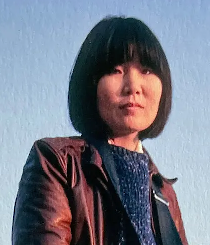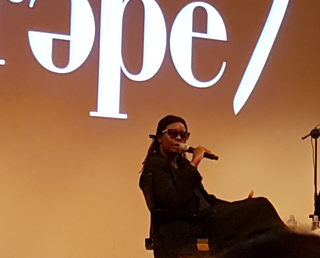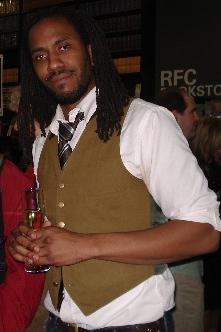
Documenta is an exhibition of contemporary art which takes place every five years in Kassel, Germany.

The Studio Museum in Harlem is an American art museum devoted to the work of artists of African descent. The museum's galleries are currently closed in preparation for a building project that will replace the current building, located at 144 West 125th Street between Adam Clayton Powell Jr. Boulevard and Lenox Avenue in Harlem, Manhattan, New York City, with a new one on the same site. Founded in 1968, the museum collects, preserves and interprets art created by African Americans, members of the African diaspora, and artists from the African continent. Its scope includes exhibitions, artists-in-residence programs, educational and public programming, and a permanent collection.
Martha Rosler is an American artist. She is a conceptual artist who works in photography and photo text, video, installation, sculpture, and performance, as well as writing about art and culture. Rosler's work is centered on everyday life and the public sphere, often with an eye to women's experience. Recurrent concerns are the media and war, as well as architecture and the built environment, from housing and homelessness to places of passage and systems of transport.

The Baltimore Museum of Art (BMA) in Baltimore, Maryland, is an art museum that was founded in 1914. The BMA's collection of 95,000 objects encompasses more than 1,000 works by Henri Matisse anchored by the Cone Collection of modern art, as well as one of the nation's finest holdings of prints, drawings, and photographs. The galleries currently showcase collections of art from Africa; works by established and emerging contemporary artists; European and American paintings, sculpture, and decorative arts; ancient Antioch mosaics; art from Asia, and textiles from around the world.

The Museum of Contemporary Art Australia (MCA), formerly the Museum of Contemporary Art, Sydney, is located on George Street in The Rocks neighbourhood of Sydney. The museum is housed in the Stripped Classical/Art Deco-styled former Maritime Services Board (MSB) building on the western side of Circular Quay. A modern wing was added in 2012.

Theresa Hak Kyung Cha was an American novelist, producer, director, and artist of South Korean origin, best known for her 1982 novel, Dictée. Considered an avant-garde artist, Cha was fluent in Korean, English, and French. The main body of Cha's work is "looking for the roots of language before it is born on the tip of the tongue." Cha's practice experiments with language through repetition, manipulation, reduction, and isolation, exploring the ways in which language marks one's identity, in unstable and multiple expressions. Cha's interdisciplinary background was clearly evident in Dictée, which experiments with juxtaposition and hypertext of both print and visual media. Cha's Dictée is frequently taught in contemporary literature classes including women's literature.

Mickalene Thomas is a contemporary African-American visual artist best known as a painter of complex works using rhinestones, acrylic, and enamel. Thomas's collage work is inspired from popular art histories and movements, including Impressionism, Cubism, Dada, the Harlem Renaissance, and selected works by the Afro-British painter Chris Ofili. Her work draws from Western art history, pop art, and visual culture to examine ideas around femininity, beauty, race, sexuality, and gender.

Charles Wilbert White, Jr. was an American artist known for his chronicling of African American related subjects in paintings, drawings, lithographs, and murals. White's lifelong commitment—to chronicling the triumphs and struggles of his community in representational form—cemented him as one of the most well-known artists in African American art history. Following his death in 1979, White's work has been included in the permanent collections of the Art Institute of Chicago, Los Angeles County Museum of Art, The Metropolitan Museum of Art, the Whitney Museum of American Art, the National Gallery of Art, The Newark Museum, and the Santa Barbara Museum of Art. White's best known work is The Contribution of the Negro to American Democracy, a mural at Hampton University. In 2018, the centenary year of his birth, the first major retrospective exhibition of his work was organized by the Art Institute of Chicago and the Museum of Modern Art.

The feminist art movement in the United States began in the early 1970s and sought to promote the study, creation, understanding and promotion of women's art. First-generation feminist artists include Judy Chicago, Miriam Schapiro, Suzanne Lacy, Judith Bernstein, Sheila de Bretteville, Mary Beth Edelson, Carolee Schneeman, Rachel Rosenthal, and many other women. They were part of the Feminist art movement in the United States in the early 1970s to develop feminist writing and art. The movement spread quickly through museum protests in both New York and Los Angeles, via an early network called W.E.B. that disseminated news of feminist art activities from 1971 to 1973 in a nationally circulated newsletter, and at conferences such as the West Coast Women's Artists Conference held at California Institute of the Arts and the Conference of Women in the Visual Arts, at the Corcoran School of Art in Washington, D.C..
David Hammons is an American artist, best known for his works in and around New York City and Los Angeles during the 1970s and 1980s.
Carrie Mae Weems is an American artist working in text, fabric, audio, digital images and installation video, and is best known for her photography. She achieved prominence through her early 1990s photographic project The Kitchen Table Series. Her photographs, films and videos focus on serious issues facing African Americans today, including racism, sexism, politics and personal identity.

Lynda Benglis is an American sculptor and visual artist known especially for her wax paintings and poured latex sculptures. She maintains residences in New York City, Santa Fe, New Mexico, Kastellorizo, Greece, and Ahmedabad, India.

Rashid Johnson is an American artist who produces conceptual post-black art. Johnson first received critical attention in 2001 at the age of 24, when his work was included in Freestyle (2001) curated by Thelma Golden at the Studio Museum in Harlem. He studied at Columbia College Chicago and the School of the Art Institute of Chicago and his work has been exhibited around the world.

Nick Cave is an American sculptor, dancer, performance artist, and professor. He is best known for his Soundsuit series: wearable assemblage fabric sculptures that are bright, whimsical, and other-worldly, often made with found objects. He also trained as a dancer with Alvin Ailey and often incorporates dance and performance into his works. His later sculptures have focused on color theory and included mixed media and large-scale installations. He lives in Chicago, Illinois, and directs the graduate fashion program at the School of the Art Institute of Chicago. He continues to work on Soundsuits as well as works completed as a sculptor, dancer, and performance artist.

Emma Amos was a postmodern African-American painter and printmaker.

Leslie Hewitt is an American contemporary visual artist.

The Nasher Museum of Art is the art museum of Duke University, and is located on Duke's campus in Durham, North Carolina, United States.

The Walther Collection is a private non-profit organization dedicated to researching, collecting, exhibiting, and publishing modern and contemporary photography and video art. The collection has two exhibition spaces: the Walther Collection in Neu-Ulm/Burlafingen, in Germany, and the Walther Collection Project Space in New York City.
Allan deSouza is a Kenyan-born American photographer, art writer, professor, and multi-media artist. He is of Indian descent and his work deals with issues of migration, relocation, and international travel. He works in the San Francisco Bay Area, and was the Chair of the Department of Art Practice at the University of California, Berkeley from 2015 - 2022.

Iliana Emilia García is a Dominican-born, American visual artist and sculptor known for large-scale paintings and installations. She is a co-founder of the Dominican York Proyecto GRÁFICA (DYPG) Collective. She lives in Brooklyn, New York.
















